Rhizoliths (Vegemorphs) and Rhizocretions
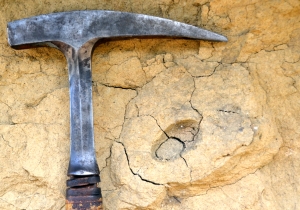 Fossil root systems that become encased in mineral matter during burial are known as rhizoliths or vegemorphs, and result when organic acids associated with roots alter the surrounding soil to create enclosing concretions. Rhizoliths may also form when roots decay, and carbonate precipitates into the remaining voids. Individual roots that display a concentric ring structure when viewed in cross-section are sometimes referred to as "rhizocretions". Mikuláš (1999) places rhizocretions and other types of rhizoliths in the proposed trace fossil class Corrosichnia, which represents traces arising from the corrosive action of plant roots. An outcrop example of a rhizocretion is shown on the right. It is from a mudstone beneath the Pleistocene Putah Tuff exposed at Putah Creek (near Lake Berryessa) on the west side of the Sacramento Valley of northern California.
Fossil root systems that become encased in mineral matter during burial are known as rhizoliths or vegemorphs, and result when organic acids associated with roots alter the surrounding soil to create enclosing concretions. Rhizoliths may also form when roots decay, and carbonate precipitates into the remaining voids. Individual roots that display a concentric ring structure when viewed in cross-section are sometimes referred to as "rhizocretions". Mikuláš (1999) places rhizocretions and other types of rhizoliths in the proposed trace fossil class Corrosichnia, which represents traces arising from the corrosive action of plant roots. An outcrop example of a rhizocretion is shown on the right. It is from a mudstone beneath the Pleistocene Putah Tuff exposed at Putah Creek (near Lake Berryessa) on the west side of the Sacramento Valley of northern California.
James St. John has also shared on the internet (flickr) some nice photos he took of Pleistocene-to-Recent rhizoliths exposed in 3D on the shoreline of Green Cay on San Salvador Island in the Bahamas. They are developed beneath a calcrete paleosol, which is basically a calcified hardground that is somewhat similar to caliche deposits found at the base of some soils in arid environments. You can look at James' photos by clicking the link here.
|
Examples of Rhizocretions and Rhizoliths (Vegemorphs)
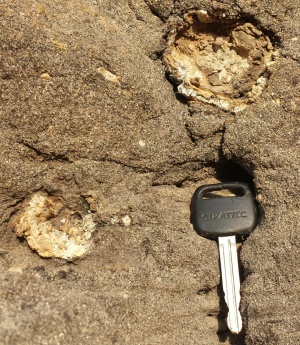 |
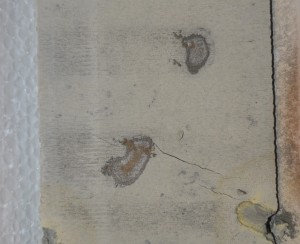
Rhizocretions in core
Miocene Temblor Fm (non-marine)
S34-404ST1 well, Coalinga oil field
West Margin San Joaquin Valley |
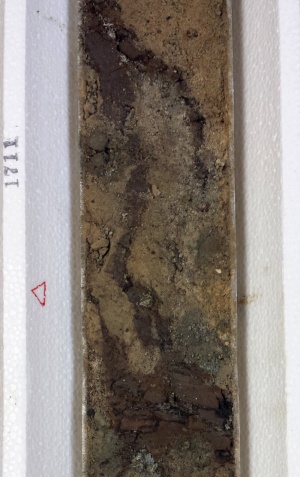
Ancient Tree Root (Rhizolith) in core
Miocene Temblor Fm (non-marine)
S34-404ST1 well, Coalinga oil field
West Margin San Joaquin Valley
The reddish-brown material replacing the root is calcareous, which leads us to believe that it either replaced the root, or precipitated into a void previously occupied by the root. |
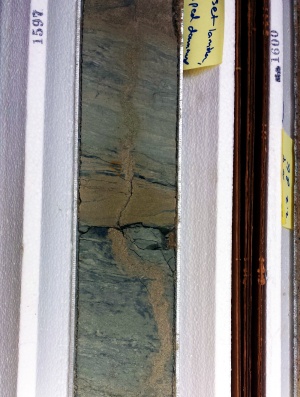
Ancient Tree Root (Rhizolith) in core
Miocene Temblor Fm (non-marine)
S34-404ST1 well, Coalinga oil field
West Margin San Joaquin Valley
This example might also be an injectite that was injected from the top down. If it is indeed an ancient tree root, then it probably formed by sand filtering down into a void left as the tree root rotted away. If such is the case, it is more properly called a "root cast", rather than a true rhizolith, which is concretionary in origin. |
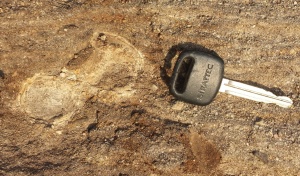
Rhizocretions in outcrop
(two photos, one above the other)
Plio-Pleistocene Tulare Fm (non-marine)
East margin of North Midway oil field
West Margin San Joaquin Basin
(notice the concretionary appearance)
|
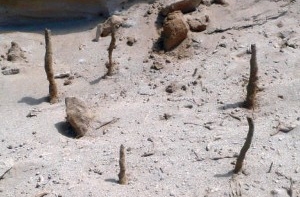
Rhizoliths in outcrop
Pleistocene to Recent beach deposits
Santa Rosa Island, east side
Offshore California |







